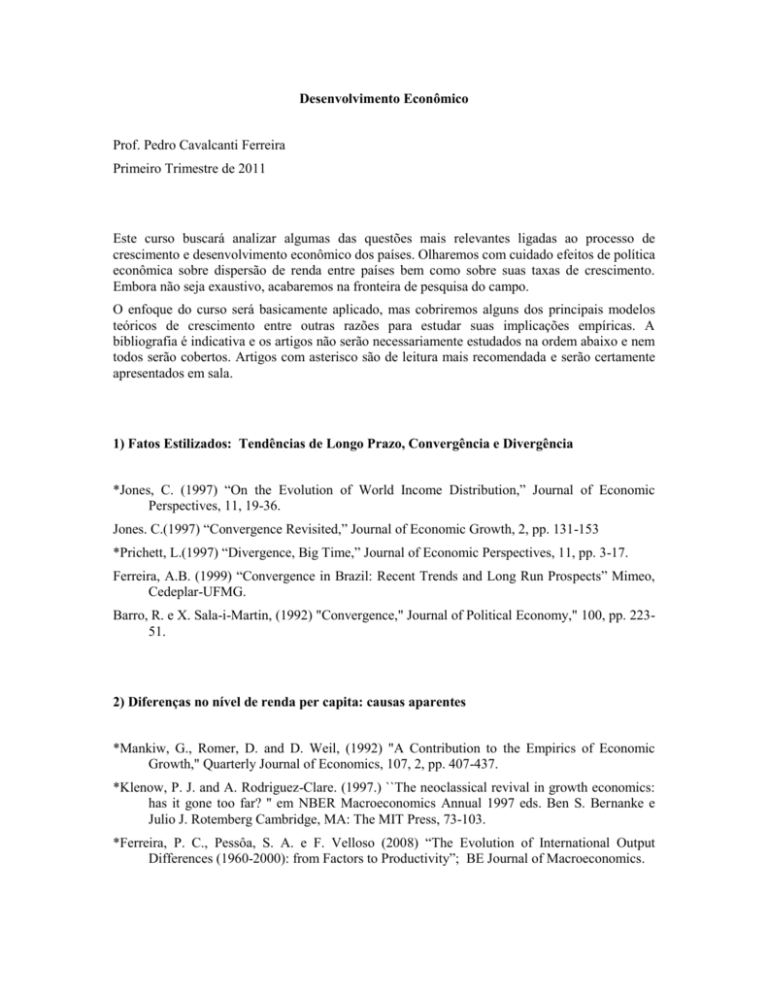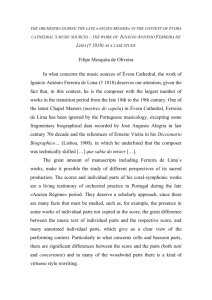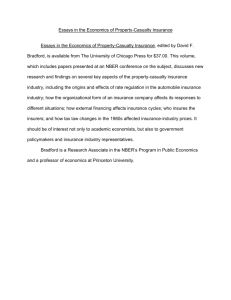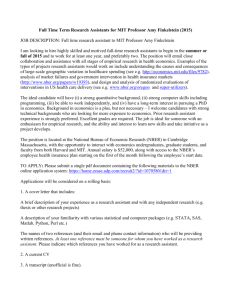Programa do curso
advertisement

Desenvolvimento Econômico Prof. Pedro Cavalcanti Ferreira Primeiro Trimestre de 2011 Este curso buscará analizar algumas das questões mais relevantes ligadas ao processo de crescimento e desenvolvimento econômico dos países. Olharemos com cuidado efeitos de política econômica sobre dispersão de renda entre países bem como sobre suas taxas de crescimento. Embora não seja exaustivo, acabaremos na fronteira de pesquisa do campo. O enfoque do curso será basicamente aplicado, mas cobriremos alguns dos principais modelos teóricos de crescimento entre outras razões para estudar suas implicações empíricas. A bibliografia é indicativa e os artigos não serão necessariamente estudados na ordem abaixo e nem todos serão cobertos. Artigos com asterisco são de leitura mais recomendada e serão certamente apresentados em sala. 1) Fatos Estilizados: Tendências de Longo Prazo, Convergência e Divergência *Jones, C. (1997) “On the Evolution of World Income Distribution,” Journal of Economic Perspectives, 11, 19-36. Jones. C.(1997) “Convergence Revisited,” Journal of Economic Growth, 2, pp. 131-153 *Prichett, L.(1997) “Divergence, Big Time,” Journal of Economic Perspectives, 11, pp. 3-17. Ferreira, A.B. (1999) “Convergence in Brazil: Recent Trends and Long Run Prospects” Mimeo, Cedeplar-UFMG. Barro, R. e X. Sala-i-Martin, (1992) "Convergence," Journal of Political Economy," 100, pp. 22351. 2) Diferenças no nível de renda per capita: causas aparentes *Mankiw, G., Romer, D. and D. Weil, (1992) "A Contribution to the Empirics of Economic Growth," Quarterly Journal of Economics, 107, 2, pp. 407-437. *Klenow, P. J. and A. Rodriguez-Clare. (1997.) ``The neoclassical revival in growth economics: has it gone too far? '' em NBER Macroeconomics Annual 1997 eds. Ben S. Bernanke e Julio J. Rotemberg Cambridge, MA: The MIT Press, 73-103. *Ferreira, P. C., Pessôa, S. A. e F. Velloso (2008) “The Evolution of International Output Differences (1960-2000): from Factors to Productivity”; BE Journal of Macroeconomics. Caselli, F 2005 “Accounting for cross-country income differences.” In: P. Aghion and S.N. Durlauf, Editors, Handbook of Economic Growth vol. 1A, North-Holland, Elsevier, New York, NY (2005), pp. 679–741. Prescott, E. (2002) "Prosperity and Depression," Federal Reserve Bank of Minneapolis Working Paper 618. 3) Diferenças de renda per capita: algumas causas fundamentais * Hall,R. and C. Jones(1999) ''Why Do Some Countries Produce so Much More Output per Worker than Others?,'' Quarterly Journal of Economics, February, Vol. 114, pp. 83-116 * Acemoglu, D., S. Johnson e J.Robison (2005) “Unbundling Institutions”, Journal of Political Economy *Easterly, W and R. Levine (2003) “Tropics, Germs and Crops: How Endowment Influenced Economic Development,” Journal of Monetary Economics, V 50.1, pp.3-39. * Estevadeordal, Antoni, Alan M. Taylor 2008. “Is the Washington Concesus dead? Growth, Opness, and the Great Liberatlization: 1970s-2000s,” NBER working paper 14264. Erosa, A., Koreshkova, T. and Restuccia, (2010) “How Important is Human Capital? A Quantitative Theory Assessment of World Income Inequality,” Review of Economic Studies, Parente, S., e Prescott, E., (1999), .Monopoly Rights: A Barrier to Riches,.American Economic Review, 89, 1216-1233. Acemoglu, D., S. Johnson e J.Robison, (2001) “The Colonial Origins of Comparative Development: An Empirical Investigation”, American Economic Review . Manuelli, R and A. Seshadri (2005) “Human Capital and the Wealth of Nations” 4) Impacto agregado de distorções microeconômicas (“misalocation”) * Restuccia, D. and R. Rogerson (2008) “Policy Distortions and Aggregate Productivity with Heterogenous Plants”, Review of Economic Dynamics, * Chang-Tai Hsieh & Peter J. Klenow, 2007. "Misallocation and Manufacturing TFP in China and India," NBER Working Papers 13290, * Ferreira, P.C and A. Trejos (2010), Gains from trade and measured total factor productivity, Review of Economic Dynamics. * Zilibotti, Song and Storesletten (2008) , “Growing Like China”, forthcoming, American Economic Review * Jones, C. Weak Links, manuscript, U.C. Berkeley. Laura Alfaro & Andrew Charlton & Fabio Kanczuk, 2008. "Plant-Size Distribution and CrossCountry Income Differences," NBER Working Papers 14060 Kehoe, T. e K. Ruhl (2010) “Why have Economic Reforms in Mexico not Generated Growth?”, FED Minneapolis, Staff Report # 453 5) Mudança Estrutural e implicações agregadas de diferenças setorias * The Role of the Structural Transformation in Aggregate Productivity By Margarida Duarte, Federal Reserve Bank of Richmond Diego Restuccia, Federal Reserve Bank of Richmond and University of Toronto. * Richard Rogerson, 2008. "Structural Transformation and the Deterioration of European Labor Market Outcomes," Journal of Political Economy, * Ferreira, P.C., Silva, L., 2011 “Structural Transformation in Latin America”, mimeo Daron Acemoglu, D and Guerrieri, V. (2006) “Capital Deepening and Non-Balanced Economic Growth” Buera, F. and J. Kaboski(2008) “The Rise of the Service Economy”, Northwestern University Restuccia, Diego & Yang, Dennis Tao & Zhu, Xiaodong, 2008. "Agriculture and aggregate productivity: A quantitative cross-country analysis," Journal of Monetary Economics Ngai, R. and Christopher Pissarides “Structural Change in a Multi-Sector Model of Growth “forthcoming in the American Economic Review. 6) O Atraso da América Latina * Ferreira, P. C., Pessôa, S. A. e F. Velloso (2008) “TFP in Latin America” *Restuccia, Diego, “The Latin American Development Problem” , Manuscript, Univ. of Toronto * Calderón, C. e L. Servén (2003) "The Output Cost of Latin America's Infrastructure Gap," Em W. Easterly e L. Servén (eds.) The Limits of Stabilization: Infrastructure, Public Deficits, and Growth in Latin America, Stanford University Press e World Bank. * Kehoe, T. e K. Ruhl (2010) “Why have Economic Reforms in Mexico not Generated Growth?”, FED Minneapolis, Staff Report # 453 Manuelli, R and A. Seshadri “East Asia vs Latin America: TFP and Human Capital Policies” Bergoeing, R., Kehoe, P., Kehoe, T. and R. Soto, 2001. "A Decade Lost and Found: Mexico and Chile in the 1980s," Review of Economic Dynamics 5, 166-205. Hopenhayn, H. A. and P.A. Neumeyer, 2004. ”Latin America in the XXth Century: Stagnation, then Collapse.” Working Paper. Cole, H. L., L. E. Ohanian, A. Riascos and J. A. Schmitz Jr., 2005. "Latin America in the Rearview Mirror". Journal of Monetary Economics, 52: 69-107. Loayza, N., Fajnzylber, P and C. Calderon (2005) “Economic Growth in Latin America and the Caribbean”, Cap 1, World Bank Press. 7) Barreiras Comerciais e Crescimento em Economias Abertas * Estevadeordal, Antoni, Alan M. Taylor 2008. “Is the Washington Concesus dead? Growth, Opness, and the Great Liberatlization: 1970s-2000s,” NBER working paper 14264. Ferreira, P.C e J.L. Rossi, (2003) “New Evidence from Brazil on Trade Liberalization and Productivity Growth,” International Economic Review, vol. 44, nº 4, November, 13831406. http://www.fgv.br/professor/ferreira/ *Frankel, D., and D. Romer(1996) “Does Trade Cause Growth?,” American Economic Review. *Alcalá F., and A. Ciccone, "Trade and Productivity", Quarterly Journal of Economics 119 (2004), 613-646 Ben-David (1993) “Equalizing Exchange: Trade Liberalization and Income Convergence,'' Quarterly Journal of Economics, 108(3), pp. 653-679. Ferreira, P.C. and A. Trejos “On the Output Efects of Barriers to Trade.”, International Economic Review, 2006, http://www.fgv.br/professor/ferreira/ Wacziarg, K Welch "Trade Liberalization and Economic Growth: New Evidence", mimeo, Stanford University, 2003 Ellen R. McGrattan & Edward C. Prescott, 2007. "Openness, technology capital, and development," Working Papers 651, Federal Reserve Bank of Minneapolis. .Dollar, D. and A. Kraay (2003) “Institutions, Trade and Growth,” Journal of Monetary Economics, V 50.1, pp.3-39. 8) Diferenças de renda per capita: transição e “modern growth” *Hansen, G. and E.C. Prescott, “From Malthus to Solow.”American Economic Review. (2002) *Ngai, R. “Barriers and the Transition to Modern Growth.” Journal of Monetary Economics, Volume 51, Issue 7, October 2004, Pages 1353-1383. *Kevin O’rourke & Jeffrey Williamson, 2005. "From Malthus to Ohlin: Trade, Industrialisation and Distribution Since 1500," Journal of Economic Growth, Springer, vol. 10(1), pages 534, 01. * Ferreira, P. Pessôa, S. e M. Santos (2010) “Globalization and the Industrial Revolution’ Desmet, K. and S. Parente (2008) “The Evolution of Markets and the Revolution of Industry,” manuscritpt, University of Illinois. Herrendorf, B., Schimitz, J. and A. Teixeira (2007) "Exploring the Implications of Large Decrease in Transportation Costs“ Acemoglu, D., S. Johnson and J. Robinson, The Rise of Europe: Atlantic Trade, Institutional Change, and Economic Growth, (AER, 2005) Galor, O. and D. Weil. (2000) “Population, Technology and Growth: From Malthusian Stagnation to the Demographic Transition and Beyond. American Economic Review 90: 806-828 9) Educação, Aposentadoria e Ciclo de Vida (se der tempo...) Soares, R., 2005. "Mortality Reductions, Educational Attainment, and Fertility Choice", American Economic Review, 95(3): pages 580-601 Ferreira, P.C. & Pessôa, S. (2002) “The Costs of Education, Longevity and the Poverty of Nations,” http://www.fgv.br/professor/ferreira/ Ferreira, P.C. & Pessôa, S. (2007) “The Effects of Longevity and Distortions on Education and Retirement”, Review of Economic Dynamics Ferreira, P.C & M. Santos (2010) “The The Effect of Social Security, Demography and Technology on Retirement Behavior”, http://www.fgv.br/professor/ferreira/ Karen A. Kopecky, 2006, The Trend in Retirement, Draft, Presented by: Karen Kopecky, University of Rochester Benhabib, J e Spiegel, M. (1994). “ The Role of Human Capital in Economic Development: Evidence from Agregate Cross-Country Data.”, Journal of Monetary Economics, nº. 34, pg 143-73. Hanushek, E. e D. D. Kimko (2000) “Schooling, Labor-Force Quality, and the Growth of Nations,” American Economic Review, 90, 5, pp.1184-1208.. Lucas, R., (1988), "On the Mechanics of Economic Development," Journal of Monetary Economics, 22, pp.3-42. 10) Inovação e Barreiras a Adoção Tecnológica (se der tempo...) Jones, C.(1995) “R&D-Based Models of Economic Growth,” Journal of Political Economy, v. 103(4), pp. 759-784. Holmes, T., e J. Schmitz Jr.(1995) “Resistentece to New Technology and Trade Between Areas,” FRB of Minneapolis Quarterly Review, winter, pp. 2-18 Coe, D.T., E. Helpman, A.Hoffmaister(1995) “North-South R&D Spillovers,” NBER Working Paper No. 5048 Parente, S. e E.C. Prescott(1994), “Barriers to Technology Adoption and Development,” Journal of Political Economy, v.102(2), 298-321. Berthold Herrendorf & Arilton Teixeira (2004) “Monopoly rights and Cross-country TFP” http://ideas.repec.org/p/red/sed004/17.html Howitt. P. (1999) “Steady State Outuput Growth with Population and R&D Inputs Growing,” Journal of Political Economy, 107, pp. 715-730 Parente, S. (1994) “Technology Adoption, Learning-by-Doing, and Economic Growth,” Journal of Economic Theory, 63, 346-369 11) Vários Hsieh and P. Klenow, Relative prices and relative prosperity, American Economic Review 97 (3) (2007), pp. 562–585. King, M. e R. Levine (1993) " Finance, Entrepreneurship and Growth" Journal of Monetary Economics¸ 1993, v.32(3), pp 513-542. Bueira, F. and. Shin, Y. (2007) “Financial Frictions and the Persistence of History: a Quantitative Exploration” Amaral and Quintin, E (2007) “Financial Intermediation and Economic Development: a Quantitiative Assessment” Kremer, M. (1995) “Population Growth and Technological Change: One Million B.C. to 1990,” Quarterly Journal of Economics, 110(2), pp. 681-716. Engerman, S. and K. Sokoloff. (2002) “Factor Endowments, Inequality, and the Path of Development Among New World Countries.” NBER Working Paper 9259 Easterly, W., 2001 “The Lost Decades: Developing Countries' Stagnation in Spite of Policy Reform 1980-1998, ”Journal of Economic Growth”, 6 (June): 135-157.







